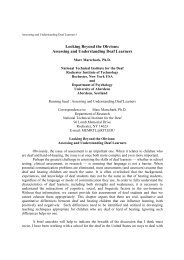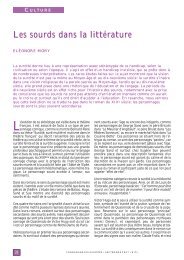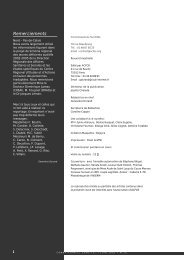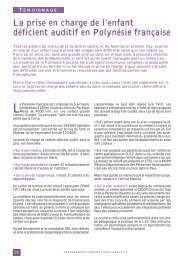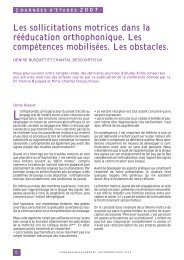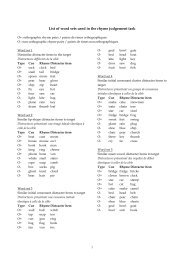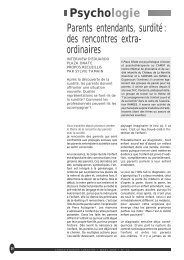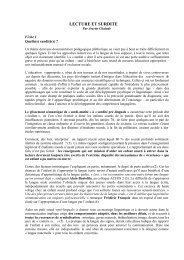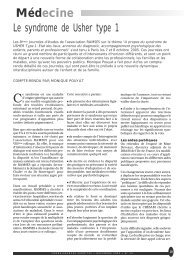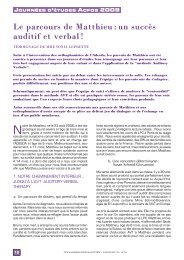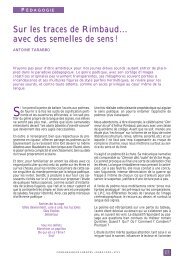A Parent Report Instrument for the Assessment of Pre ... - ACFOS
A Parent Report Instrument for the Assessment of Pre ... - ACFOS
A Parent Report Instrument for the Assessment of Pre ... - ACFOS
- No tags were found...
You also want an ePaper? Increase the reach of your titles
YUMPU automatically turns print PDFs into web optimized ePapers that Google loves.
Dr. Es<strong>the</strong>r DROMISchool <strong>of</strong> Education – Tel Aviv UniversityRamat Aviv 69978 (Israël)Phone : 972 3 640 7118Fax : 972 3 640 9477ٱedromi@netvision.net.il ٱ HYPERLINK mailto : edromi@netvision.net.il ٱ : E-mailA <strong>Parent</strong> <strong>Report</strong> <strong>Instrument</strong> <strong>for</strong> <strong>the</strong> <strong>Assessment</strong> <strong>of</strong> <strong>Pre</strong>-LinguisticCommunication in Hearing Impaired ChildrenIntroductionThe utilization <strong>of</strong> parent’s questionnaires in <strong>the</strong> indirect assessment <strong>of</strong> early languagedevelopment by very young typically developing children has become a common researchpractice (e.g., Bates, et al., 1994 ; Camaioni, Caselli, longobardi, & Volterra, 1991). The use<strong>of</strong> parents as a primary source <strong>of</strong> in<strong>for</strong>mation is especially constructive with very youngsubjects whose language behaviors are highly context bound, and are linked to <strong>the</strong> social andphysical contexts <strong>of</strong> <strong>the</strong> home environment. The relative ease <strong>of</strong> administering parent’s reportinstruments allow to collect data from large samples <strong>of</strong> children without <strong>the</strong> need <strong>for</strong> trainedobservers. From published reports we can learn that parents <strong>of</strong> young typical children providereliable and valid in<strong>for</strong>mation on <strong>the</strong> pre-linguistic and <strong>the</strong> early lexical development <strong>of</strong> <strong>the</strong>irown children (e.g., Dale, Bates, Reznick, & Morisset, 1989).The rationale <strong>for</strong> testing <strong>the</strong> utilization <strong>of</strong> a parent report instrument with clinicalpopulation was motivated by research as well as by clinical considerations. We hypo<strong>the</strong>sizedthat <strong>the</strong> active involvement <strong>of</strong> <strong>the</strong> parents in describing <strong>the</strong>ir child’s communicative abilitieshas <strong>the</strong> following advantages :- It makes available to <strong>the</strong> clinician important in<strong>for</strong>mation on <strong>the</strong> child’s earlycommunicative behaviors at <strong>the</strong> home.- It enhances <strong>the</strong> parent’s responsibility with regard to <strong>the</strong> child’s early rehabilitation.- It contributes to parent’s awareness and understanding <strong>of</strong> new concepts and terms, andhelps in establishing a “common” language between <strong>the</strong> clinician and <strong>the</strong> parent.The Goals <strong>of</strong> <strong>the</strong> present StudyThe two main goals <strong>of</strong> <strong>the</strong> present study were to test <strong>the</strong> utilization <strong>of</strong> a parent questionnairewith a clinical population <strong>of</strong> hearing impaired children (HIC) who are older in age andmanifest developmental delays and to assess and to characterize <strong>the</strong> communicative abilities<strong>of</strong> pre-linguistic HIC.<strong>Instrument</strong>In 1992 Camaioni, Caselli, Volterra and Luchenti published in Italian, a highlystructured parent report instrument that was constructed on <strong>the</strong> basis <strong>of</strong> detailed researchfindings on pre-linguistic developments during <strong>the</strong> first two years <strong>of</strong> life. This parent’squestionnaire evaluates pre-linguistic communication in two types <strong>of</strong> natural contexts : <strong>the</strong>physical context in which <strong>the</strong> child is being cared <strong>for</strong> in terms <strong>of</strong> basic needs (e.g., food,diaper, changing, sleep), and <strong>the</strong> social-routine play context in which <strong>the</strong> parent-child
interaction has no instrumental value (e.g., <strong>the</strong> peekaboo game, and picture book telling). TheCamaioni et al., instrument is unique since it requires a direct observation in data collection.A set <strong>of</strong> six different physical and play contexts are presented to <strong>the</strong> parents as a set <strong>of</strong>questions, and <strong>the</strong>y are asked to observe <strong>the</strong>ir child in each context several times and <strong>the</strong>n toreport about <strong>the</strong> behaviors noted in that context. For each <strong>of</strong> <strong>the</strong> six contexts, a close set <strong>of</strong>motor, gestural, vocal and linguistic behaviors are specified as optional responses. <strong>Parent</strong>s areasked to indicate how frequently each behavior that is specified on <strong>the</strong> list is produced by <strong>the</strong>child in a three-point scale <strong>of</strong> never, sometimes, and <strong>of</strong>ten.The instrument also contains two closed lists <strong>of</strong> 15 first words and 15 referentialgestures which tend to emerge closely to <strong>the</strong> beginning <strong>of</strong> comprehensible speech (Dromi,1993). The parent is asked to mark which words and gestures <strong>the</strong> child produces, to indicatehow frequently <strong>the</strong> word or gesture is produced, and to specify <strong>the</strong> situations in which <strong>the</strong>y areobserved.In <strong>the</strong> adaptation <strong>of</strong> <strong>the</strong> parent questionnaire <strong>for</strong> our population (Dromi, 1992), wetranslated it into Hebrew, and added to <strong>the</strong> list <strong>of</strong> optional responses under each questionseveral items on <strong>the</strong> use <strong>of</strong> conventional signs. We adopted <strong>the</strong> lists <strong>of</strong> first words and firstgestures according to <strong>the</strong> research on <strong>the</strong> early development <strong>of</strong> Hebrew (Dromi, 1987), wecreated a third list <strong>of</strong> 19 early emerging signs from Israeli Sign language.The six questions (Contexts) in <strong>the</strong> Questionnaire :1. what does <strong>the</strong> child do when he/she is hungry?2. what does <strong>the</strong> child do when he/she wants to go out?3. how does <strong>the</strong> child behave when he/she wants a toy?4. when <strong>the</strong> preferred person is absent, what does <strong>the</strong> child do to call him/her?5. when you look at/read a book toge<strong>the</strong>r, what does <strong>the</strong> child do?6. when you play “peekaboo” toge<strong>the</strong>r, what does <strong>the</strong> child do?The items that appear as optional responses <strong>for</strong> <strong>the</strong> question : “when a preferred person isabsent, what does <strong>the</strong> child do to call him/her?”- looks <strong>for</strong> <strong>the</strong> person where he usually is/where <strong>the</strong> child expects to find him orher- Cries- Takes an adult who is present to <strong>the</strong> place where <strong>the</strong> absent person might be- Points to <strong>the</strong> place where <strong>the</strong> absent person usually is- Indicates by gesture or facial expression that he is looking <strong>for</strong> somebody- Vocalizes to call a person- Uses a word to call <strong>the</strong> person- Uses a sign to call <strong>the</strong> personThe subjects48 parents <strong>of</strong> pre-linguistic HIC participated in <strong>the</strong> study.There were 27 boys and 21 girls in <strong>the</strong> sample.Most subjects (89,6%) were born to hearing parents.Subject’s ages are range between 8 and 49 months (mean age 23 months).The degree <strong>of</strong> hearing loss ranged from mild and moderate (6,25% mild, 31,25% moderate) tosevere and pr<strong>of</strong>ound hearing losses <strong>of</strong> 91 DB or more (62% <strong>of</strong> <strong>the</strong> sample).Most subjects were diagnosed even be<strong>for</strong>e <strong>the</strong>y were 18 months old (91,5%).Mean age <strong>for</strong> <strong>the</strong> beginning <strong>of</strong> language intervention was 13,4 months (SD-8,9 months).
Seventy percent <strong>of</strong> <strong>the</strong> families who participated in <strong>the</strong> study were from low and middle-lowSES. The rest <strong>of</strong> <strong>the</strong> families were divided equally between <strong>the</strong> middle high (14,6%) and <strong>the</strong>high (16,7%) SES.The procedureA written introduction which explained <strong>the</strong> rationale <strong>for</strong> including <strong>the</strong> questionnairewithin <strong>the</strong> complete pre-linguistic assessment, a summary <strong>of</strong> its goals, and an explanation <strong>of</strong><strong>the</strong> terms : vocalizations, gestures, signs, and words, was given to <strong>the</strong> parents by <strong>the</strong> languageclinician. The written document was <strong>the</strong>n discussed in a very simple manner supported byconcrete examples. <strong>Parent</strong>s were instructed to fill in <strong>the</strong> questionnaire only after <strong>the</strong>y havegained familiarity with <strong>the</strong> tool, and by selecting one question at a time. It was emphasizedthat several observations <strong>of</strong> <strong>the</strong>ir child’s behaviors in each context must be conducted prior to<strong>the</strong> actual reporting. <strong>Parent</strong>s were asked to return <strong>the</strong> questionnaires within two weeks.Inter-Judge ReliabilityAn experienced language researcher, visited <strong>the</strong> homes <strong>of</strong> 9 families who represented<strong>the</strong> entire sample with regard to age, degree <strong>of</strong> hearing loss, and SES. She conducted directobservations on <strong>the</strong> child in two out <strong>of</strong> <strong>the</strong> six contexts that appear in <strong>the</strong> questionnaire. TheInter-judge agreement on <strong>the</strong> same two contexts <strong>for</strong> all subjects ranged from 74,4% to 91,6%with an average <strong>of</strong> 86,3%.ResultsThe questionnaire data were coded according to <strong>the</strong> following eight categories :Crying (C), Independent Behaviors (I), Use <strong>of</strong> Adults (A), Pointing (P), Gesture (G),Vocalizations (V), Words (W), Signs (S).A Smallest Space Analysis (SSA) was per<strong>for</strong>med on all questionnaire items across allgroup results.The SSA examined whe<strong>the</strong>r <strong>the</strong> a-priory categorization system fitted our data. PearsonCorrelations were calculated among all <strong>the</strong> categories used <strong>for</strong> analysis to test <strong>the</strong> relationshipamong <strong>the</strong>m. In this statistical analysis a relatively high positive correlation between <strong>the</strong>average score <strong>of</strong> two or more items is signified by spatial proximity, while a relatively highnegative correlation between two items or more is represented by a greater distance.Table 1 : The Correlations among <strong>the</strong> Eight Categories <strong>of</strong> Analysis
- Some categories were more homogeneous than o<strong>the</strong>rs.- Two groups <strong>of</strong> related categories are identified.- Significant high positive correlations are found among <strong>the</strong> early emerging categories<strong>of</strong> Independent Behaviors, Use <strong>of</strong> Adults, and Pointing.- No significant correlations were found between Pointing or Gesture and Word orSigns.Pointing was <strong>the</strong> most homogeneous category. The categories <strong>of</strong> IndependentBehaviors and Use <strong>of</strong> Adults were also homogeneous. The items belonging to <strong>the</strong> categories<strong>of</strong> Words and Signs were somewhat more sparse. Items belonging to <strong>the</strong> categories <strong>of</strong> Cry,Vocalizations, and Gesture are dispersed throughout <strong>the</strong> figure, indicating that <strong>the</strong> differentitems belonging to <strong>the</strong>se categories were not strongly related to each o<strong>the</strong>r, and that <strong>the</strong>secategories were less distinct than o<strong>the</strong>rs.The first group <strong>of</strong> related categories is that <strong>of</strong> Pointing, Independent Behaviors, andUse <strong>of</strong> Adults (see <strong>the</strong> lower left hand-side <strong>of</strong> <strong>the</strong> display). The second group <strong>of</strong> relatedcategories consists <strong>of</strong> <strong>the</strong> categories <strong>of</strong> Words and Vocalizations (see <strong>the</strong> upper-central level<strong>of</strong> <strong>the</strong> display). Note that <strong>the</strong> category Sign is located in <strong>the</strong> right lower hand-side <strong>of</strong> <strong>the</strong>display as a separate category.While Pointing is used by hearing infants relatively late in <strong>the</strong> pre-linguistic stage, andclosely to <strong>the</strong> emergence <strong>of</strong> <strong>the</strong> first words, in our sample <strong>of</strong> HIC, pointing was positivelycorrelated with <strong>the</strong> relatively simplistic communicative behaviors <strong>of</strong> per<strong>for</strong>ming an action incollaboration with adults, <strong>the</strong> amount <strong>of</strong> vocalizing, and with <strong>the</strong> production <strong>of</strong> gestures. Thefinding that early emerging, non-symbolic behaviors are closely linked to <strong>the</strong> behavior <strong>of</strong>Pointing is important as it indicates that <strong>the</strong> in <strong>the</strong> case <strong>of</strong> HIC pointing is not predictive <strong>of</strong>true symbolic behaviors <strong>of</strong> signs and words.The finding that Gestures were positively correlated with <strong>the</strong> Use <strong>of</strong> Adults, Pointing,and Vocalizations, and were not correlated with <strong>the</strong> production <strong>of</strong> words and signs, fur<strong>the</strong>r
supports <strong>the</strong> claim that representational basis <strong>for</strong> <strong>the</strong> generation <strong>of</strong> gestures might be differentthan <strong>the</strong> representational basis <strong>for</strong> <strong>the</strong> generation <strong>of</strong> conventional symbols which are usedlinguistically (Petitto, 1992).Pearson correlations between <strong>the</strong> scores in each <strong>of</strong> <strong>the</strong> three closed lists <strong>of</strong> words,signs, and referential gestures, and <strong>the</strong> eight categories <strong>of</strong> analysis fur<strong>the</strong>r explored <strong>the</strong>relationships between <strong>the</strong> production <strong>of</strong> words, signs, and referential gestures with o<strong>the</strong>r prelinguisticbehaviors in HIC.Table 2 : The Correlations between <strong>the</strong> List’s Scores and <strong>the</strong> Eight CategoriesTable 3 : <strong>the</strong> correlation between <strong>the</strong> Eight CategoriesCategories <strong>of</strong> analysis :Crying (C) ; Independent behavior (I) ; Collaboration with an adult (A) ; Pointing (P) ;Gestures (G) ; Vocalization (V) ; Words (W) ; Signs (S)- The scores in <strong>the</strong> list <strong>of</strong> gestures were positively correlated with four differentcategories <strong>of</strong> pre-linguistic behaviors. Namely, Use <strong>of</strong> Adults, Pointing, Gesture, andIndependent Behaviors.- The scores in <strong>the</strong> list <strong>of</strong> signs were positively correlated only with <strong>the</strong> score in <strong>the</strong>category <strong>of</strong> Signs.- The scores in <strong>the</strong> list <strong>of</strong> words were positively correlated with <strong>the</strong> score in <strong>the</strong> category<strong>of</strong> Words. A positive and significant correlation was also found between <strong>the</strong> score in<strong>the</strong> list <strong>of</strong> words ant <strong>the</strong> scores in <strong>the</strong> categories Pointing, Use <strong>of</strong> Adults, and Gesture.These correlations, however, were somewhat lower.
The high and positive correlations between <strong>the</strong> scores in <strong>the</strong> close list <strong>of</strong> words, signs, andgestures, and in <strong>the</strong> scores <strong>of</strong> <strong>the</strong> same categories in <strong>the</strong> more structured sections <strong>of</strong> <strong>the</strong>questionnaire indicate that <strong>the</strong> internal validity <strong>of</strong> <strong>the</strong> questionnaire is high. These resultsshow that <strong>the</strong> tasks <strong>of</strong> :1) conducting direct observations in specific contexts and2) selecting responses from a closed list optional responsesare effective.Conclusions :I. The Camaioni et al., parent report instrument is a useful clinical tool <strong>for</strong> <strong>the</strong>assessment <strong>of</strong> pre-linguistic behaviors in HIC.II. <strong>Parent</strong>s <strong>of</strong> HIC provide a reliable report on <strong>the</strong>ir children’s pre-linguisticcommunication abilities by means <strong>of</strong> direct observation in <strong>the</strong> home environment.III. The set <strong>of</strong> eight categories <strong>for</strong> analysis that we have utilized in our research appear tobe appropriate <strong>for</strong> evaluating <strong>the</strong> communicative abilities <strong>of</strong> HIC.IV. Pointing was clustered toge<strong>the</strong>r with <strong>the</strong> early emerging behaviors in <strong>the</strong> pre-linguisticstage. The relatively older age <strong>of</strong> our HIC, as well as <strong>the</strong> delay in learning language,might explain why pointing was associated with early and non-symbolic behaviors.V. The production <strong>of</strong> gestures was not related to <strong>the</strong> production <strong>of</strong> signs and words. Thiscategory was idiosyncratic and was not as distinct as <strong>the</strong> o<strong>the</strong>r categories. Our resultsindicate that <strong>the</strong> use <strong>of</strong> gestures in HIC increases as independent behaviors, use <strong>of</strong>adults, pointing and vocalizations increase.VI. The representational basis <strong>for</strong> <strong>the</strong> generation <strong>of</strong> gestures seem to be different than <strong>the</strong>representational basis <strong>for</strong> <strong>the</strong> generation <strong>of</strong> conventional symbols that are usedlinguistically.ReferencesBates, E., Markman, V., Thal, D., Fenson, I., Dale, P., Reznick, J.S., Reilly, J., & Hartung, J.(1994).Developmental and stylistic variation in <strong>the</strong> composition <strong>of</strong> early vocabulary. Journal <strong>of</strong> ChildLanguage, 21, 85-123.Camaioni, L., Caselli, M.C. Longobardi, E., & Volterra, V. (1991). A parent report instrument<strong>for</strong> early language assessment. First Language 11, 345-359.Camaioni, L., Caselli, M.C., Volterra, V. & Luchenti, S. (1992). Questionario sullo sviluppoComunicativo e Linguistico nel secondo anno di vita. Firenze : Organizziazioni Speciali.Dale, P.S., Bates, E., Reznick, J.S., & Morisset, C. (1989). The validity <strong>of</strong> a parent reportinstrument <strong>of</strong> child language at twenty months. Journal <strong>of</strong> Child Language, 16, 239-249.Dromi, E. (1987). Early lexical development. London : Cambridge University <strong>Pre</strong>ss.Dromi, E. (1992). “KESHER” : A language rehabilitation program <strong>for</strong> preschool hearingimpaired children. Unpublished manuscript. School <strong>of</strong> Education, Tel Aviv University.Dromi, E. (1993). The development <strong>of</strong> pre-linguistic communication : implications <strong>for</strong>language evaluation. In N.J. Anastasiou and S. Harel (Eds.), At risk infants : Interventions, familiesand research. Baltimore : Paul H. Brookes Publishing.Hartman, M. (1975). <strong>Pre</strong>stige grading <strong>of</strong> occupations with sociologists as judges. Paperpresented at <strong>the</strong> 70 th Meeting <strong>of</strong> <strong>the</strong> American Sociological Association, Chicago.Petitto, L.A. (1992). Modularity and constraints in early lexical acquisition : Evidence fromchildren’s language and gesture. In M.R. Gunnar & M. Maratsos (Eds.), Modularity and constraints inlanguage and cognition. The Minnesota Symposium on Child Psychology, Vol. 5.
Treitel, H. (1995). The development <strong>of</strong> communication in pre-linguistic hearing impairedchildren. MA Thesis, School <strong>of</strong> Education, Tel Aviv University.The criterion by which subjects were selected was <strong>the</strong> spontaneous production <strong>of</strong> less than10 comprehensible words <strong>of</strong> <strong>the</strong> use <strong>of</strong> 10 consistent conventional signs. See Treitel (1995)<strong>for</strong> a more detailed description <strong>of</strong> <strong>the</strong> sample and <strong>the</strong> procedures.SES was computed on <strong>the</strong> basis <strong>of</strong> parent’s education and occupation (Hartman, 1975).The complete pre-linguistic assessment consisted <strong>of</strong> a1) a detailed evaluation <strong>of</strong> non-verbal behaviors conducted by <strong>the</strong> clinician;2) an analysis <strong>of</strong> video-recorded dyadic interaction between <strong>the</strong> mo<strong>the</strong>r and herchild, and3) <strong>the</strong> parent report instrument.



